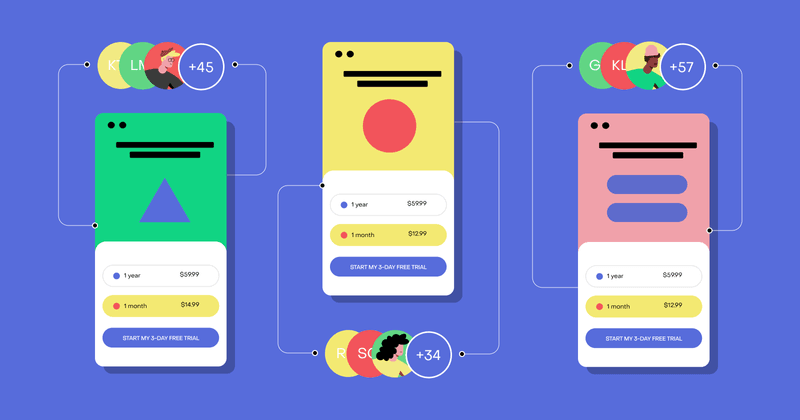Effective monetization of subscription apps requires personalized strategies.
RevenueCat Targeting allows you to optimize every element of your paywall by target audience and in-app placement.
This blog outlines practical ways to use Targeting for fine-tuning how you monetize your app, from localized pricing to offers aimed at users on a specific platform. These are intended to both illustrate the breadth of what you can achieve with Targeting, as well as give you tangible ideas that you can experiment with yourself.
To get the most out of this blog, consider watching Developer Advocate Charlie’s video on how Targeting works within RevenueCat.
Target Offerings by specific countries
Customizing your Offerings for each country allows you to align them with local purchasing power, preferences, and feature availability.
Tailoring to local markets
Customized trial offers: Adapt the presence, duration, and pricing of trial offers to suit local preferences. In some markets, longer trial periods may be more effective, while in others, shorter but more feature-rich trials could lead to higher conversion rates.
Highlight different features: Advertise different feature bundles on your paywall based on what resonates with the specific needs and interests of users in each country. For example, bundle features that cater to regional trends or popular habits.
Case study: During our mobile pricing experiments webinar, Keya Patel, former Director of Product Management, Growth at Headspace, highlighted a unique challenge. Despite offering lower prices in specific markets, Headspace encountered cultural barriers towards concepts like mindfulness and mental health. This showed that in certain regions, it wasn’t pricing that needed to be optimized, but their messaging and feature-set.
Localized paywall design: Customize the layouts and designs of your paywalls to align with local cultural aesthetics, making the paywall more appealing and user-friendly. Also, if using testimonials on your paywall, you can tailor them to the country you’re targeting.
Strategic pricing and subscription plans
Localized pricing strategies: Adjust price points to match the purchasing power and typical spending habits in each market. This could involve lower prices in price-sensitive markets (e.g. Brazil) or premium pricing where users are willing to pay more. An index like the Big Mac index could give you a starting point.
Case study: Video-editing app Mojo increased yearly pricing in certain countries, including the US and Germany, by 50% for new users with “minimal adverse effects on the free-to-paid conversion rate”. Similarly, they reduced pricing in other countries, like Brazil, providing both short and long-term benefits. When evaluating which regions to test lower prices in, in addition to using purchasing power indexes, look at your own metrics: a low new-to-trial/conversion rate could indicate a lower point would be beneficial. Read Mojo’s story.
Varied subscription durations: Experiment with different subscription durations (monthly, quarterly, yearly) to see which aligns best with the usage patterns and preferences in each country.
One-time purchase vs. subscription: Preferences between one-time purchases and subscriptions can vary by country. In some regions, users may favor the simplicity of a one-time purchase. For example, in India, regulatory changes have made one-time purchases more appealing than subscription models, due to challenges with subscription auto-renewals.
Target Offerings by specific platforms
iOS and Android users have distinct behaviors and preferences, as well as device capabilities. Targeting enables you to fine-tune your app’s Offerings to each platform’s audience.
For Android users:
Longer introductory offers: Since Android users might be more price-sensitive, try extending the length of introductory offers. This could mean a longer trial period or a discounted rate for the initial months.
Stacked offers: Experiment with a combination of offers, like a short free trial followed by a discounted subscription period, to gradually ease users into a full-priced subscription.
For iOS users:
Diverse package mix: Explore the option of introducing a variety of higher-value package options for iOS users, such as adding a lifetime plan. This approach caters to the diverse preferences of iOS users, offering them a valuable choice that aligns with their willingness to make a long-term commitment.
Annual subscription incentives: Consider introducing special incentives for iOS users who choose an annual subscription, such as a heightened discount. Such incentives acknowledge and reward the commitment of iOS users who are more likely to opt for longer-term plans.
Target Offerings by specific versions of your app
By targeting Offerings based on app version, you ensure that each user receives the most appropriate and attractive options.
New app versions
Exclusive trials for latest features: Offer exclusive trial periods for new features that are only available in the latest app version. Strategically combine this with a customer messaging integration to trigger personalized messaging.
Older app versions
Backwards compatibility for your RevenueCat Paywall footer: If you’re using RevenueCat Paywalls, ‘Display Methods’ allows you to pair a pre-built purchase component, like a footer, with your own custom paywall design. If newer versions of your app feature new design elements, Targeting allows you to control which footer you present by app version to ensure you’re presenting a consistent branding experience by version.
Simplified Offerings for compatibility: If your app includes various premium tiers, it’s important to cater to users on older versions with Offerings that match their app’s capabilities. Tailor simpler subscription plans for these versions, focusing on core features that remain compatible and valuable. This approach ensures that all users, regardless of the app version they use, have access to a meaningful and functional subscription option.
Encouragement to upgrade: Use the paywall to encourage users of older versions to upgrade to the latest version. For example, edit your paywall design to show what they’re missing out on and offer a seamless upgrade path.
Sunsetting older versions: When planning to phase out an older version, offer special incentives for users to move to a newer version, such as a one-time discount on the first month of a newer subscription tier.
Target Offerings by specific versions of the RevenueCat SDK
Manage RevenueCat Paywall SDK compatibility: Utilize Targeting to ensure users see paywall templates compatible with their specific RevenueCat SDK version. This prevents fallback to a default template on older versions, maintaining a consistent and optimized paywall experience across all user segments.
Target Offerings by in-product placement
Showing your paywall at the right moment can make a big difference. Targeting allows you to choose when and where your paywall appears.
- When users hit a gated feature: Show custom paywalls at critical moments. For example, when a user explores a premium (gated) feature, present a paywall that’s not just timely but also explains the feature’s value with tailored design and messaging. This approach makes each interaction as relevant as possible.
- Onboarding: Deciding on how soon to show a paywall — before, during, or after onboarding — can be tricky. Is it best after a few screens, or right at the end? Many developers are overly cautious, but the answer lies in testing. By experimenting with different timings, you can discover what works best for your app and users. If you’re concerned about showing a paywall too early, remember that most users are used to it.
Case study: Panic attack relief app Rootd increased revenue by 5x by placing their paywall near the beginning of onboarding.
- After specific actions: Let’s say a user completes a task in your app or opens it a certain number of times. You can set up a paywall to appear right after these actions. This way, you’re making offers when the user is already engaged and might be more open to subscribing.
📚Further reading: Explore our guide to paywall placement optimization for more best practices and case studies.
Target Offerings by custom attribute
Attributes in RevenueCat allow you to save unique structured information about your customers and it is up to you how you use them. Targeting allows you to easily choose by which attribute you wish to personalize. You could, for example, target based on:
- Feature usage: When users show a preference for certain features, make sure those are front and center in your offers. Tailoring paywalls to reflect the features or content users engage with most not only validates their interest but also encourages conversion.
- Demographics: Tailor your messaging, offers, and pricing to resonate with specific demographic groups. For students, consider offering discounts that cater directly to them. Adjust your paywall’s imagery to reflect the user’s age group and gender. Much of this demographic data can be collected during onboarding, providing a foundation for further personalization.
- User-expressed goals and interests: Use insights from onboarding surveys to present paywalls that align with users’ expressed goals or interests. This immediate relevance can be the key to winning a subscriber early on. The customization needn’t be complex. Babbel, for example, tweak their paywall headline based on your learning goal:
- Referral link used: Customize your offer based on how a user finds your app. If a user arrives through a partner link, adjust your paywall to reflect the terms of the referral, such as special pricing or exclusive features, making the offer feel personalized and exclusive.
📚Further reading: This is the perfect use case to combine with an influencer marketing campaign.
- Paywalls previously viewed: Adapt your paywall based on the user’s history with your app. If a user has seen but not converted on previous paywalls, consider altering your design, messaging, or offers. This approach allows you to build a narrative over time.
How to analyze your Targeting
To gauge the effectiveness of your targeted strategies, use RevenueCat Charts to segment and analyze key metrics by Offerings. This approach provides insights into how different targeted groups respond to your strategies. You can segment the following charts by Offerings:
- Active Trials and Active Subscriptions: Understand user uptake for each Offering.
- Churn, Refund Rate, and Subscription Retention: Assess the longevity and satisfaction with your Offerings.
- Revenue Metrics (ARR and MRR): Measure financial impact.
By segmenting these charts by Offerings, you can pinpoint which strategies are resonating with your audience and adjust accordingly.
Unlock more growth with Targeting
With Targeting, you have more options to optimize your app’s monetization strategy. Tailor your Offerings to align with specific markets, platforms, and app versions to directly address user preferences and increase conversion rates. Implement localized pricing, extended trials for Android users, or highlight exclusive features for newer app versions easily.
Dive into Targeting today and start crafting tailored targeted Offerings.
As we continue to improve and expand upon this feature, we’d value your feedback. Let us know your thoughts by filling in this brief survey.

